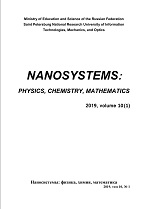|
This article is cited in 2 scientific papers (total in 2 papers)
PHYSICS
Design of 2:4 and 3:8 decoder circuit using QCA technology
Ratna Chakrabartya, S. Roya, T. Pathaka, D. Ghosha, N. K. Mandalb
a Institute of Engineering & Management, Department of Electronics & Communication Engineering, Salt Lake Electronics Complex, Sector V, Kolkata, 700091, India
b University of Engineering & Management, Department of Electronics & Communication Engineering, Salt Lake Electronics Complex, Sector V, Kolkata, 700091, India
Abstract:
Quantum Dot Cellular Automata is an emerging technology in the field of nanotechnology and has the potential to replace the existing CMOS technology. CMOS technology has its limitations in terms of high leakage current. However, QCA technology has higher speed of operation and very low power consumption. In this paper, designs for 2–4 and 3–8 decoder circuits have been made using a novel inverter circuit design which helps in decreasing the energy dissipation of the circuits. Finally, the proposed designs are compared to previously made designs. All the circuits in this paper have been simulated using QCA Designer software.
Keywords:
QCA, decoders, laser ablation, majority voter, kink energy.
Received: 25.05.2021
Citation:
Ratna Chakrabarty, S. Roy, T. Pathak, D. Ghosh, N. K. Mandal, “Design of 2:4 and 3:8 decoder circuit using QCA technology”, Nanosystems: Physics, Chemistry, Mathematics, 12:4 (2021), 442–452
Linking options:
https://www.mathnet.ru/eng/nano1039 https://www.mathnet.ru/eng/nano/v12/i4/p442
|

| Statistics & downloads: |
| Abstract page: | 84 | | Full-text PDF : | 344 |
|




 Contact us:
Contact us: Terms of Use
Terms of Use
 Registration to the website
Registration to the website Logotypes
Logotypes








 Citation in format
Citation in format 
